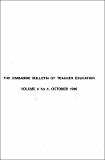| dc.description.abstract | The study describes and evaluates the role of the Zimbabwe Teachers’ Association in the professional and academic development of teachers. The aim of the study is to increase the reader’s knowledge and understanding of the association and to explore its changing role. Having been an active member of the Southern Rhodesia African Teachers’ Association (S.R.A.T.A.) from 1961 to 1964, the author also attempts to assess the progress that has been made over the past thirty years and to describe the possibilities and problems of the association.
Information was obtained through a study of the association’s published documents, literature searches on professional education and organizations, personal contacts and interviews with some members of the association and the National Executive in Harare.
The study revealed that whereas teachers were trying to assume control of their own professional development, they were, to a large extent, unable to influence their conditions of service, partly because ZIMTA is an association as opposed to a union and partly because of Zimbabwe’s desire to make education one of the basic rights in the country. This has entailed the recruitment of everyone who is willing and able to teach and with the minimum academic and professional qualifications. Entry into and exit from the profession has thus become difficult to control. The study further revealed that the association has not yet gained a strong and relevant role in the vetting of unsuitable and under-qualified members. It was also noted that the existence of the Zimbabwe Teachers’ Union (ZITU) prevented the articulation of a unified position on a number of important issues.
The problems that militate against professionalism were identified as many and varied. They include hot seating, the low status enjoyed by the teaching profession because of uncompetitive salaries, the fragmentation of the teaching force as evidenced by membership either to ZIMTA or ZITU, inadequate support in the classroom, inadequate parental support and ill-conceived teacher development and inservice programmes.
The author argues that in order for ZIMTA to be regarded as representative of the majority of teachers, it will have to embark on a vigorous and sustained membership drive, draft a constitution which articulates the aspirations of a wide spectrum of teachers with varying qualifications and interests, achieve a standardisation of entry qualifications for all teacher preparation programmes, continue to provide opportunities for its members to acquire concepts, attitudes, skills, knowledge and dispositions necessary for effective teaching, lobby parliamentarians for the enactment of education legislation in which teaching will be recognised as a genuine profession. Above all, it will have to work more zealously for the professional, social and material welfare of its members. Failure to maintain the delicate balance between its professional and trade union roles would result in depressed morale and act as a disincentive to professional development. | en_GB |


